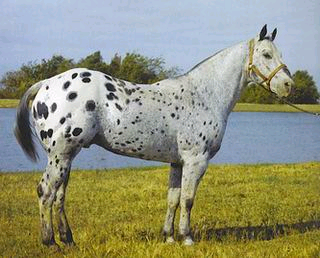Joker B

When Joker B. was foaled in 1941, breeder Jack Casement was more than frustrated with the spotted blanket covering the dark colt’s hind end. Despite the foals’ good looks and conformation, Casement was a staunch Quarter Horse breeder, and he found Joker B’s appearance to be, at best, offensive. Joker B.’s sire was Casement’s prize Quarter Horse stallion Red Dog, who was from a long line of solid colored horses. Suspicion, therefore, was immediately cast on Blue Vitriol, a Coke Roberd's-bred roan mare that Casement had bought specifically to cross with Red Dog (indeed, it had been Casement's hope the breeding would produce a Quarter Horse superior even to his prize stallion). The breeding had in fact produced a quality foal, but that foal had inherited some of his dam's’s previously overlooked Appaloosa genes – genes Jack Casement wanted nothing to do with. With no other use for the spotted colt, Casement gave him to his wife Xenia, who in turn sold him to their neighbor Jack Blasingame for a sum of two hundred and fifty dollars – which she promptly spent on a new vacuum cleaner.
A few weeks after purchasing the colt, the shrewd Blasingame sold the colt for $750 to Bob Cantrell of Reno, Nevada, and Cantrell then sold the colt to Tommy Young of Las Vegas, Nevada. It was Young who gave the yearling horse a new name: previously known as Domino, the colt now became Joker. As a yearling Joker began to shed his previously dark coat to a blue roan (which would lighten more and more as the years passed), and the horse was easily recognizable by the dark varnish mark on his nose. After being broke to ride as a two year old, Joker was used often as an all around ranch horse and in rodeos as a bulldogging, hazing, and pickup horse. Young never promoted Joker as a stallion, but if a mare owner asked to use Joker as a sire, Young never refused, and offered Joker’s stallion services for free. In 1946 Joker met Lee Berry of Barstow, California. Berry was only there to breed a mare, but ended up asking to buy the stallion from Young. Not wanting to sell his best ranch horse, Young asked $1,500 for the stallion, not thinking the price would be met. Berry did indeed match the price, and Joker moved to California, where he was registered in the Appaloosa Horse Club as Joker B.
Joker continued his career in rodeos, and his calm nature even allowed Berry and his wife Betty to use him in a performance where Berry rode a Brahman bull being lead by Betty, who was in turn mounted on Joker. In 1949, thanks to Joker’s AQHA pedigree and rodeo times, the stallion was registered with the American Quarter Horse Racing Association, and Joker was quickly became known as a stallion that sired top quality rodeo horses.
In 1953, Bill Benoist bought the stallion from Berry and began to promote him, first by entering Joker in the Appaloosa National Show in 1953. Twelve year old Joker came away with a first place in the 220 yard race. In 1954, Joker started in eight races at Los Alamitos, and won six of them, all running against Quarter Horses often half his age. He continued to win and place at shows, and finally, at the age of fifteen, Joker B. won grand champion stallion honors at the 1956 Calizona Appaloosa Horse Show, his son Joker’s Flying Star taking reserve. Joker also won a first place in Get of Sire. He repeated his Get of Sire win again the next year, and placed in halter and several performance classes as well, winning high point honors at the 1957 Calizona show. At age 17, he placed high in get of sire, aged stallions, reining, and won a jackpot stake race at the International Appaloosa Show in San Antonio, Texas.
After a good showing at the 1959 San Antonio Livestock Exposition, Joker B. was sold again – this time for $10,000 – to Carl Miles of the Cee Bar Ranch in Texas. Under Miles’ ownership, Joker B. was shown less and less, but became much more visible as an Appaloosa ambassador and stallion. Miles acquired top a top quality broodmare band for the stallion, and Joker’s stallion services were advertised nationwide in Western Horseman; Miles also gave framed reproductions of Darol Dickinson’s Joker B. portrait to hotels and restaurants. Joker’s spotted coat was seen on NBC’s “Today” show, at parades ridden by people from the Governor of Texas to the reigning Miss Texas, and was ridden at a rodeo by television star Dick Boone of “Have Gun Will Travel”.
In 1965, Carl Miles sold Joker B. – once less valued than a vacuum cleaner – for $26,000 at auction. The horse was bought by a four man syndicate which included Miles; the syndicate then closed Joker B.’s services to outside mares.
Joker B. sired winning names such as 1958 National grand champion mare Jessie Joke, high point winner Joker’s Flying Star, and race winner Joker’s Moneca. Joker B’s name is on a countless number of cutting horse pedigrees, including that of Appaloosa History inductees Ima Doc O’Lena and Cherry’s Leader.
On July 13, 1966, after his last breeding season, twenty-five year old Joker B. died of natural causes. He was inducted into the Appaloosa Horse Club Hall of Fame in 1988.


